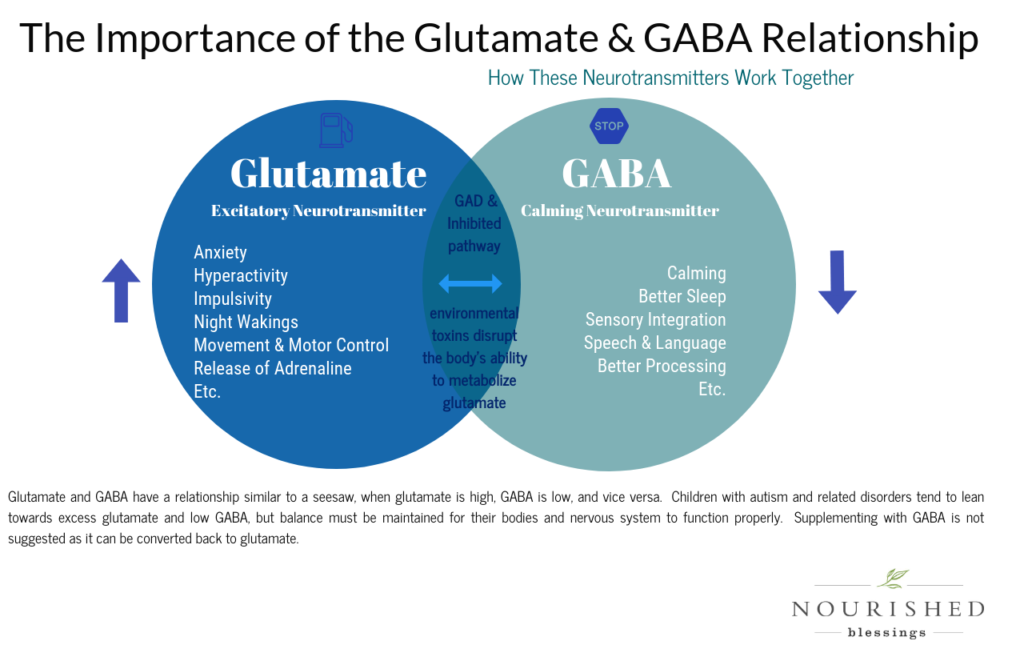As an excitatory neurotransmitter, glutamate is behind ADD/ADHD. Glutamate is also the most abundant neurotransmitter, responsible for regulating over 50% of the nervous system. It is classified as an excitatory neurotransmitter, which means it excites or stimulates nerve cells located throughout the nervous system. As you can imagine, when the brain is overexcited, it will lead to an increase in hyperactivity, impulsivity, and impact movement and motor control. When glutamate is in excess it is extremely toxic to the brain and nervous system. It can become so excitatory, it is considered an excitotoxin, which means that it overstimulates brain cells to the point of killing them or damaging them enough to cause severe mitochondrial dysfunction (associated with low muscle tone) and neurological inflammation. You will often hear about the dopamine and GABA connection to ADD/ADHD, but dopamine and GABA signaling is dependent & regulated by glutamate and glutamate signaling. More and more science is being released on how glutamate alters dopamine signaling, all of which contribute to hyperactivity. In general, working to lower glutamate and balance these neurotransmitters should make a substantial improvement in hyperactivity.
This is not a comprehensive list, simply some articles I have found along the way that may help to explain the glutamate and ADHD/hyperactivity connection.
A blog post from our integrative pediatrician on the gluten/casein connection to ADHD. She even touches on the glutamate component. http://www.sheilakilbane.com/could-adhd-be-caused-by-gluten-and-dairy/
“Attention-deficit/hyperactivity disorder (ADHD) is a developmental disorder characterized by a deficit in behavioral inhibition. Recent evidence also suggests a deficit in cortical inhibition via the GABA (γ-aminobutyric acid)–ergic system.” Reduced GABA Concentration in Attention-Deficit/Hyperactivity Disorder https://www.ncbi.nlm.nih.gov/pmc/articles/PMC3970207/
Striatal Creatine and Glutamate/Glutamine in Attention-Deficit/Hyperactivity Disorder Results: Striatal glutamate, glutamate/glutamine (Glx) and creatine concentrations were greater in the ADHD subjects at baseline as compared to controls. Only striatal creatine, not glutamate or Glx, was reduced after stimulant treatment in the ADHD patients. No significant differences between groups were noted in the remainder of the striatal metabolites or any of the occipital lobe or prefrontal cortex metabolites.Conclusions: These findings provide initial evidence of a striatal creatine/glutamatergic dysregulation in ADHD. http://online.liebertpub.com/doi/abs/10.1089/cap.2006.0008
“Attention-deficit/hyperactivity disorder (ADHD) and autism spectrum disorders (ASD) often co-occur. Both are highly heritable; however, it has been difficult to discover genetic risk variants. Glutamate and GABA are main excitatory and inhibitory neurotransmitters in the brain; their balance is essential for proper brain development and functioning. In this study we investigated the role of glutamate and GABA genetics in ADHD severity, autism symptom severity and inhibitory performance, based on gene set analysis, an approach to investigate multiple genetic variants simultaneously. Common variants within glutamatergic and GABAergic genes were investigated using the MAGMA software in an ADHD case-only sample (n=931), in which we assessed ASD symptoms and response inhibition on a Stop task. Gene set analysis for ADHD symptom severity, divided into inattention and hyperactivity/impulsivity symptoms, autism symptom severity and inhibition were performed using principal component regression analyses. Subsequently, gene-wide association analyses were performed. The glutamate gene set showed an association with severity of hyperactivity/impulsivity (P=0.009), which was robust to correcting for genome-wide association levels. The GABA gene set showed nominally significant association with inhibition (P=0.04), but this did not survive correction for multiple comparisons. None of single gene or single variant associations was significant on their own. By analyzing multiple genetic variants within candidate gene sets together, we were able to find genetic associations supporting the involvement of excitatory and inhibitory neurotransmitter systems in ADHD and ASD symptom severity in ADHD” Glutamatergic and GABAergic gene sets in attention-deficit/hyperactivity disorder: association to overlapping traits in ADHD and autism https://www.ncbi.nlm.nih.gov/pubmed/28072412
“Insufficient levels of GABA result in nervousness, anxiety and panic disorders, aggressive behavior, decreased eye-contact and anti-social behavior, attention deficit, problems with eye-focusing (like that seen in autistic children when both eyes are focused inward towards the nose or waver back and forth in a horizontal or vertical movement), chronic pain syndromes and much more. It may also contribute to GERD as it is needed to help regulate the lower part of the esophagus.” (http://www.holistichelp.net/blog/how-to-increase-gaba-and-balance-glutamate/)
“OCD and ADHD/DAMP are common neuropsychiatric conditions which in many regards appear to be each other’s antipodes with respect to clinical manifestations, associated personality traits and brain biochemistry, notably prefrontal cortical glutamate activity. Future pharmacological treatments of these disorders may involve manipulations with glutamate, dopamine D1, serotonin 22A and nicotine receptors” http://www.sciencedirect.com/science/article/pii/S0278584600001469
“Early life stress has been shown to alter glutamate and GABA transmission, and in particular, to alter GABAA receptor expression. The LC–NE system has been implicated in attention-deficit/hyperactivity disorder (ADHD), amongst other disorders, and is over-responsive to glutamate stimulation in a validated rat model of ADHD, the spontaneously hypertensive rat (SHR). It is plausible that the LC–NE system, or glutamate and GABA modulation thereof, in an individual already genetically predisposed to develop ADHD, or in SHR, may respond in a unique way to early life stress.” http://www.sciencedirect.com/science/article/pii/S0006899312019610
“As a result, inadequate dopamine neurotransmission from the striatum allows uncontrolled glutamate release, and the resultant excess glutamate signaling increases behavioral responsiveness to external stimuli, i.e. increases distractibility (Russell, 2003). Following this line of reasoning, Ludolph et al. (2010) support the claim that excessive glutamate stimulation of the striatum from the prefrontal cortex results in the clinical manifestations of ADHD. Atomoxetine, a fairly new treatment for ADHD, was initially proposed to be effective through its support of norepinephrine transmission. However, Ludolph et al. found that the drug can also antagonize the N-methyl D-aspartate (NMDA) receptor, a type of glutamate receptor, and that this effect may have a role in atomoxetine’s success in treating ADHD.”
http://www.corepsych.com/2010/11/adhd-and-glutamate-neurotransmitters/
Autism One Presentation on the ADHD Glutamate connection with Dr. Reid:
Stories of Hope





